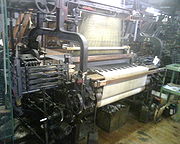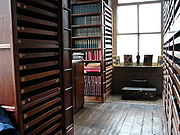
Moxon Huddersfield
Encyclopedia
Moxon Huddersfield Ltd is a high-end British textile manufacturer of luxury worsted
and woollen suiting fabric
s. It is located at Yew Tree Mills, Holmbridge, near Huddersfield
, in Yorkshire
.
 The company was incorporated in 1924 but claims it can trace its roots to the 16th century. In the 1910s, it traded under the name of "B. H. Moxon & Sons" and was located at Springfield Mills, Kirkburton
The company was incorporated in 1924 but claims it can trace its roots to the 16th century. In the 1910s, it traded under the name of "B. H. Moxon & Sons" and was located at Springfield Mills, Kirkburton
, near Huddersfield. At that time it patented an improvement to the dobby loom
. It was incorporated in 1924 In the 1930s, it was exporting to Japan and the United States.. In 1950, it moved to a new site in Kirkburton.
In the 1950s, it was noted for its fancy worsted fabrics, In the 1980s, it was specialized in worsted mohair
and silk blends aimed primarily at the Japanese market.
Moxon was one the first British weavers to replace British Dobcross loom
s with wider Swiss Sulzer looms. In the early 1960s, after the retirement of Matthew Moxon, it was part of the Tulketh Group, which went into receivership in the early 1970s. It was acquired in 1971 by the Allied Textiles group.
 The company was acquired in 1993 by Firas Chamsi-Pasha, a Syrian former agent of Hield
The company was acquired in 1993 by Firas Chamsi-Pasha, a Syrian former agent of Hield
. Mr Chamsi-Pasha dropped 90% of the company's customer base and concentrated its production in the most expensive segment of the cloth market, with retail price up to £ 4,200 a metre in 2005 for fabrics such as a 12.9 micron wool or a super-fine wool with an 18 ct gold stripe. Mr Chamsi-Pasha marketed Super
180s fabrics in 1998 and Super 210s fabrics in 2000. He claimed in 2003 he was willing to pay "silly prices" to acquire wool with a fiber measuring less than 12 microns and had bought 26 pounds of wool with a fiber measuring 11.5 microns. The company uses antique machinery together with up-to-date equipment, such as a £120,000 scouring machine.
In 2006, Joanne Alsop, then head designer of the company, won a Silver Shuttle Award from the Worshipful Company of Weavers
. As of 2010, the company was using 8 looms and producing about 500 single pieces or 35,000 metres per year, using archives going back to the 1930s for ideas. As of 2011, its fabric are priced between £300 ($480) and £11,000 ($17,600) per meter. 95% of the production is exported.
from the Altai region. They were priced at £400 ($640) in 2011. The company claims to sell 140 pairs per year.
Worsted
Worsted , is the name of a yarn, the cloth made from this yarn, and a yarn weight category. The name derives from the village of Worstead in the English county of Norfolk...
and woollen suiting fabric
Textile
A textile or cloth is a flexible woven material consisting of a network of natural or artificial fibres often referred to as thread or yarn. Yarn is produced by spinning raw fibres of wool, flax, cotton, or other material to produce long strands...
s. It is located at Yew Tree Mills, Holmbridge, near Huddersfield
Huddersfield
Huddersfield is a large market town within the Metropolitan Borough of Kirklees, in West Yorkshire, England, situated halfway between Leeds and Manchester. It lies north of London, and south of Bradford, the nearest city....
, in Yorkshire
Yorkshire
Yorkshire is a historic county of northern England and the largest in the United Kingdom. Because of its great size in comparison to other English counties, functions have been increasingly undertaken over time by its subdivisions, which have also been subject to periodic reform...
.
History

Kirkburton
Kirkburton is a village, civil parish and local government ward in the metropolitan county of West Yorkshire, England, south east of Huddersfield, in the Metropolitan Borough of Kirklees...
, near Huddersfield. At that time it patented an improvement to the dobby loom
Dobby loom
A Dobby Loom is a type of floor loom that controls the whole warp threads using a device called a dobby. Dobby is a corruption of "draw boy" which refers to the weaver's helpers who used to control the warp thread by pulling on draw threads....
. It was incorporated in 1924 In the 1930s, it was exporting to Japan and the United States.. In 1950, it moved to a new site in Kirkburton.
In the 1950s, it was noted for its fancy worsted fabrics, In the 1980s, it was specialized in worsted mohair
Mohair
Mohair usually refers to a silk-like fabric or yarn made from the hair of the Angora goat. The word "mohair" was adopted into English before 1570 from the Arabic: mukhayyar, a type of haircloth, literally 'choice', from khayyara, 'he chose'. Mohair fiber is approximately 25-45 microns in...
and silk blends aimed primarily at the Japanese market.
Moxon was one the first British weavers to replace British Dobcross loom
Loom
A loom is a device used to weave cloth. The basic purpose of any loom is to hold the warp threads under tension to facilitate the interweaving of the weft threads...
s with wider Swiss Sulzer looms. In the early 1960s, after the retirement of Matthew Moxon, it was part of the Tulketh Group, which went into receivership in the early 1970s. It was acquired in 1971 by the Allied Textiles group.
Today

Hield
Hield Bros, or Hield , is a British textile manufacturer and retailer of men's clothing and luxury goods. The company was established in 1922...
. Mr Chamsi-Pasha dropped 90% of the company's customer base and concentrated its production in the most expensive segment of the cloth market, with retail price up to £ 4,200 a metre in 2005 for fabrics such as a 12.9 micron wool or a super-fine wool with an 18 ct gold stripe. Mr Chamsi-Pasha marketed Super
S number (wool)
An S number on the label of a wool suit, or other tailored wool apparel, indicates the fineness of the wool fiber used in the making of the apparel. The numbers may also be found on wool fabric and yarn. The S numbers for fine wool products are intended to state, with precision, the fineness of the...
180s fabrics in 1998 and Super 210s fabrics in 2000. He claimed in 2003 he was willing to pay "silly prices" to acquire wool with a fiber measuring less than 12 microns and had bought 26 pounds of wool with a fiber measuring 11.5 microns. The company uses antique machinery together with up-to-date equipment, such as a £120,000 scouring machine.
In 2006, Joanne Alsop, then head designer of the company, won a Silver Shuttle Award from the Worshipful Company of Weavers
Worshipful Company of Weavers
The Worshipful Company of Weavers is the most ancient of the Livery Companies in the City of London. It existed in the year 1130, and was perhaps formed earlier. The Company received a Royal Charter in 1180. At present, the Company retains a connection to textiles through its contributions to the...
. As of 2010, the company was using 8 looms and producing about 500 single pieces or 35,000 metres per year, using archives going back to the 1930s for ideas. As of 2011, its fabric are priced between £300 ($480) and £11,000 ($17,600) per meter. 95% of the production is exported.
Cashmere Socks
The company introduced in 1999 socks woven with a very fine cashmereCashmere wool
Cashmere wool, usually simply known as cashmere, is a fiber obtained from Cashmere and other types of goats. The word cashmere derives from an old spelling of Kashmir. Cashmere is fine in texture, and strong, light, and soft. Garments made from it provide excellent...
from the Altai region. They were priced at £400 ($640) in 2011. The company claims to sell 140 pairs per year.

